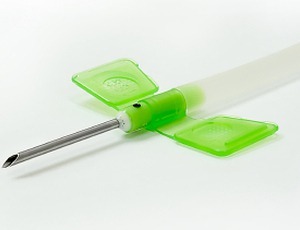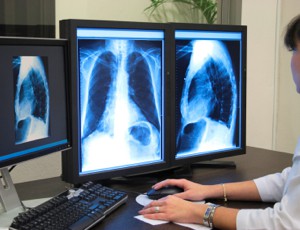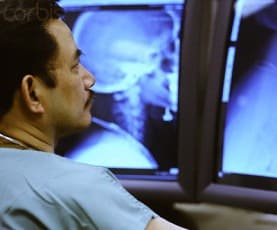Novel needleless connector results in dramatic decrease in CLABSI

We wanted to determine if the use of a novel needleless connector, impregnated with chlorhexidine and silver ions, paired with nursing education to consistently apply best practices would reduce CLABSI rates in a high-risk population” McCombs and Cisar (2018). Background: Central lines are a common device in Intensive Care Unit (ICU) and oncology patients, however, […]
Femoral placed totally implantable central venous access port
We present a case of a 70-year-old colorectal adenocarcinoma patient diagnosed with subclavian vein hypoplasia. Her care team decided intraoperatively to implant a port system by the right femoral access” Cherkashin et al (2018). Abstract: Totally implanted venous access port (TIVAP) systems provide adequate quality of care and life, especially for oncology patients. Long-term vascular […]
How often do we perform painful procedures in the paediatric intensive care unit?

The primary objective was to determine the number of painful and stressful procedures per patient per day in our PICU patients, including the numbers of attempts” Baarslag et al (2018). Abstract: BACKGROUND: Adequate analgesia and sedation is crucial in critical care. There is little knowledge on the extent of painful and stressful procedures on children […]
Vascular access selection in elderly patients starting hemodialysis
In elderly hemodialysis patients initiating hemodialysis therapy with a catheter, the optimal vascular access selection depends on tradeoffs between shorter catheter dependence and less frequent interventions to make the vascular access (AVG) functional versus longer access patency and fewer interventions after successful use of the vascular access (AVF)” Lee et al (2018). Abstract: RATIONALE & […]
Inadvertent right vertebral artery rupture during dialysis catheter insertion
We report the case of a 79-year-old female dialysis patient who suffered a vertebral artery (VA) injury complicated by a herald bleeding on the 3rd post-intervention day after an internal jugular vein dialysis catheter replacement” Tasopoulou et al (2018). Abstract: Central venous (CV) catheterization is not only an invaluable diagnostic modality but also an essential […]
Incidence of midline catheter-associated bloodstream infections

Unlike CLABSI, reporting of BSIs associated with MCs is not mandatory and the incidence of MC-associated BSIs (MLABSIs) has not been extensively studied. The objective of this study was to determine MLABSI incidence” Hogle et al (2018). Background: A midline catheter (MC) is a non-central venous catheter that may remain in place for up to […]
Hub disinfection technique to prevent central line-associated blood stream infections

Increasing evidence shows using Chlorhexidine Gluconate (CHG) may help prevent certain health care associated infections, and may also prove beneficial for the prevention of CLABSI” Cooney et al (2018). Background: Central line-associated blood stream infection (CLABSI) events lead to increased complications, costs, morbidity and mortality. A review of CLABSI events was conducted at a large […]
Focus on central line dressings and infusion tubing care as a CLABSI prevention methodology

The most common causes of CLABSIs are related to imperfect maintenance of the line and associated tubing” Parada et al (2018). Background: Central line associated blood stream infections (CLABSI) endanger patient safety and increase morbidity, mortality, length of stay and the cost of medical care. The most common causes of CLABSIs are related to imperfect […]
Expert-based recommendations for OPAT services in Spain

The objective of this clinical guideline is therefore to provide evidence- and expert-based recommendations with a view to standardizing clinical practice in this care modality and contribute to a progressive increase in the number of patients who can be cared for and receive intravenous therapy in their own homes” López Cortés et al (2018). Abstract: […]
The challenge of learning to self-cannulate arteriovenous access

Patients with end-stage kidney disease who are considering home hemodialysis (HHD) face the challenge of learning to self-cannulate their arteriovenous access” Ward et al (2018). Abstract: Patients with end-stage kidney disease who are considering home hemodialysis (HHD) face the challenge of learning to self-cannulate their arteriovenous access. Current practice discourages the use of tunneled central […]
Augmented reality glasses in central line insertion simulation

The aim of this study was to investigate the feasibility of using augmented reality (AR) glasses in central line simulation by novice operators and compare its efficacy to standard central line simulation/teaching” Huang et al (2018). Abstract: OBJECTIVE: The aim of this study was to investigate the feasibility of using augmented reality (AR) glasses in […]
Intraperitoneally located tip of femoral central venous catheter

It was concluded that in any case of acute abdominal issues, following insertion of femoral venous catheter, evaluation of catheter misplacement by the means of contrast injection through it can be helpful for better diagnosis, and may help avoid unnecessary surgical interventions” Shafiee et al (2018). Abstract: Central venous catheterization is a common procedure in […]
Epidemiology of catheter-related bloodstream infections in cancer patients

We compared the etiologic organisms of bloodstream infections (BSIs) in cancer patients with central venous catheters (CVCs) between 2 cohorts separated by more than a decade” Chaftari et al (2018). Abstract: We compared the etiologic organisms of bloodstream infections (BSIs) in cancer patients with central venous catheters (CVCs) between 2 cohorts separated by more than […]
Malposition of central venous catheter due to radiation-induced venous stenosis

CXR was done postinsertion to confirm the position of CVC, which revealed that the tip of the catheter was in the right internal jugular vein (IJV)” Extract: “The day before surgery, using the standard Seldinger technique with portable ultrasound (ACUSON, Siemens) guidance, the right subclavian vein (SV) was cannulated with 7 Fr triple-lumen central venous […]
The subclavian vein approach for central venous catheter insertion

In this report, we describe a patient with a chemotherapy port placed in the subclavian vein that underwent spontaneous fracture” Sun and Soares (2018). Introduction: Central venous catheters (CVCs) are commonly used and have a range of outpatient and inpatient indications. A subclavian vein approach has traditionally been used for placement of these catheters; however, […]
Effectiveness of infusion filters to remove particulate contamination during a multidrug infusion protocol

We have investigated the ability of IV in-line filters to eliminate particulate matter from multidrug infusion lines and so prevent contamination. The impact on particle occurrence of the internal volume of the IV line below the in-line filter was then evaluated” Perez et al (2018). Abstract: The large number of drugs administered simultaneously to neonates […]
Subclavian central venous catheter complications at insertion

The aim of the present study was to determine the success of the placement of CVCs without ultrasonographic guidance and the number and type of complications associated with insertion of these” Hernández-Franco and and Martínez-Ordaz (2018). Abstract: BACKGROUND: Central Venous Catheters (CVC) are used as a tool in critically ill patients requiring hemodynamic monitoring and […]
Effect of phellodendron wet compress in treating infusion phlebitis
Aim of the study was to observe and analyze the clinical effect of phellodendron wet compress in treating the phlebitis caused by infusion” Wan (2018). Abstract: Aim of the study was to observe and analyze the clinical effect of phellodendron wet compress in treating the phlebitis caused by infusion. The research objects were 600 cases […]
Ultrasound-guided vascular cannulation in critically-ill pediatric patients

To describe the characteristics of ultrasound-guided vascular cannulation in critically-ill pediatric patients” López Álvarez et al (2018). Abstract: INTRODUCTION: Central vascular cannulation in children is a highly complex technique and poses many difficulties. Vascular ultrasound can make this procedure easier. OBJECTIVE: To describe the characteristics of ultrasound-guided vascular cannulation in critically-ill pediatric patients. POPULATION AND […]
Septic pulmonary emboli as a complication of peripheral IV catheter insertion

We describe a case of widespread cellulitis and septic pulmonary emboli as a complication of peripheral venous cannulation” Baidya et al (2018). Abstract: Septic pulmonary emboli can occur as a complication of many diseases, most common being right sided infective endocarditis. Septic emboli through a peripheral venous cannula are rarely reported in literature though central […]
Risk factors for CLABSI in adult hematopoietic cell transplant patients

There is a lack of data regarding the incidence and risk factors associated with the development of CLABSIs in the HCT population undergoing outpatient transplantation” McDonald et al (2018). Abstract: BACKGROUND: Allogeneic hematopoietic cell transplant (HCT) patients are at an increased risk of developing central line-associated bloodstream infections (CLABSIs) due to prolonged periods of myelosuppression, […]
Ultrasound-guided CVAD insertion in children weighing ten kilograms or less

This paper analyses the safety of USG percutaneous CVAD insertion in the pediatric population weighing ten kilograms or less” Vierboom et al (2018). Abstract: PURPOSE: Ultrasound-guided (USG) percutaneous insertion of tunnelled central venous access devices (CVADs) has been shown to be safe and effective in adults. However, there have been concerns over the safety of […]
Enhanced central venous catheter bundle for parenteral-dependent pediatric patients
CLABSI occurs more frequently among high-risk pediatric patients, such as those with intestinal failure (IF) who are parenteral nutrition (PN) dependent. Following an increase in CLABSI rates, a quality improvement (QI) initiative was implemented” Ormsby et al (2018). Abstract: Background: Central line–associated bloodstream infections (CLABSIs) cause substantial morbidity and increase antimicrobial use and length of […]
Management of cancer-associated upper extremity deep vein thrombosis

The objective of this study was to determine risk factors for UEDVT and the rates of recurrence and bleeding in a real-world setting” ALKindi et al (2018). Abstract: INTRODUCTION: Data on management of upper extremity deep vein thrombosis (UEDVT) in patients with cancer is limited. The objective of this study was to determine risk factors […]
Prevalence of central vein stenosis in patients referred for vein mapping

Central vein stenosis is considered to be common in patients on hemodialysis but its exact prevalence is not known. In this study, we report the prevalence of central vein stenosis in patients with CKD referred for vein mapping” Tedla et al (2018). Abstract: BACKGROUND AND OBJECTIVES: Central vein stenosis is considered to be common in […]
Recent developments in molecular based bloodstream infection diagnostic platforms

To review recent developments in molecular based diagnostic platforms used for the identification of bloodstream infections, with a focus on assays performed directly on blood samples and positive blood cultures” Peker et al (2018). Abstract: Background: Bloodstream infections are a major cause of death with increasing incidence and severity. Blood cultures are still the gold […]
Influence of needle gauge used for venipuncture in cats

The objective of this study was to evaluate the effect of different needle sizes used to obtain blood via jugular venipuncture in cats on routine measures of hemostasis” Solbak et al (2018). Abstract: Objectives: The objective of this study was to evaluate the effect of different needle sizes used to obtain blood via jugular venipuncture […]
Principles of fluid management and stewardship in sepsis

There are only four major indications for intravenous fluid administration: aside from resuscitation, intravenous fluids have many other uses including maintenance and replacement of total body water and electrolytes, as carriers for medications and for parenteral nutrition” Malbrain et al (2018). Abstract In patients with septic shock, the administration of fluids during initial hemodynamic resuscitation […]
ECG for positioning catheter tip during PICC placement in neonates

During the PICC placement in neonates, the use of ECG monitor to determine the position of catheter tip can improve the one-time success rate of placement and reduce the time spent on placement” Ling et al (2018). Abstract: OBJECTIVE: To study the efficiency of electrocardiogram (ECG) monitor for positioning the catheter tip in the placement […]
Catheter-tip thrombus formation following implantable central venous port placement

In this large cohort, younger patients and those with more advanced stage breast cancer were more associated with catheter-tip-related thrombus after port placement” Makary et al (2018). Abstract: Purpose: Catheter-tip associated thrombosis is not uncommon in patients with implantable central venous ports; however, the prevalence and clinical impact of this complication on patient management is […]

